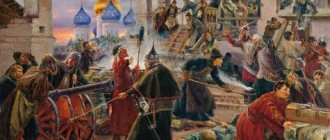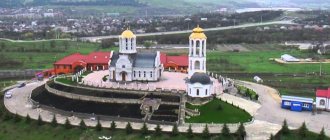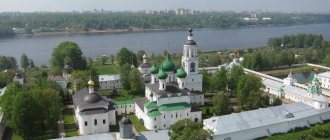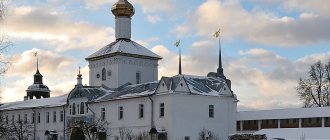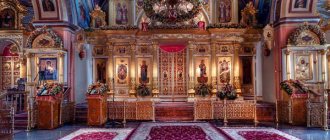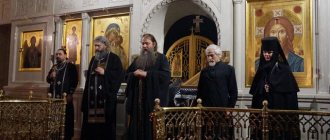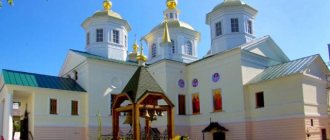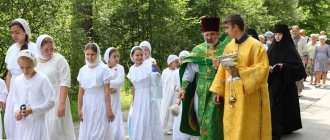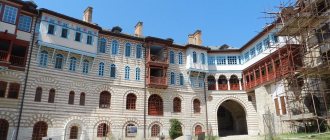film Abode of Faith and Love watch online – Orthodox films online
| 1 34 Nadezhda (05/06/2017 03:16) I watch the film almost every day and every day I find something new for myself. Save me, God! Low bow to you. |
| 33 Tatiana (12/28/2016 21:56) After watching the film, my soul began to ache and begged to go to this monastery. I ask myself - is it just out of curiosity? But the soul turns out to want grace. God bless Father Sergius and all the nuns of the monastery. Lord help them in the matter of salvation, in prayer and work. |
Ural Shrines – Sredneuralsky Monastery and Ganina Yama
Good Sunday, dear friends and subscribers! Last weekend I took a trip that I had long dreamed of. There are many beautiful monasteries in the Urals, and I especially wanted to go to 2 of them - this is the Sredneuralsky women’s monastery in honor of the icon of the Mother of God “Spreader of the Loaves” and the men’s monastery in the name of the Royal Passion-Bearers Ganina Yama.
I was on Ganina Yama while I was still at school, on an excursion with French schoolchildren, and even then the monastery struck me with its wooden churches, the holiness of this place, and its special silence.
And my correspondence acquaintance with the Sredneuralsky Convent happened thanks to nun Nina (Krygina) and her lectures on the psychology of family relationships, as well as thanks to the film “Abode of Faith and Love” (I recommend everyone to watch it).
On this trip, the charming Katya kept me company, we calmly walked through the territory of the monasteries, as if hidden in the shade of trees, enjoyed the reflections of the sun on the beautiful, bright domes, talked, and here and there we were lucky to get to part of the services and listen to the wonderful singing of the choir.
Let's start with a visit to the Sredneuralsky convent.
Brief information about the monastery: The land where the farmstead is located previously belonged to the subsidiary farm of the Central Ural State District Power Plant. During wartime there was a prisoner of war camp there, so this place was popularly called the German Farm. In August 2002. The “German Farm” was donated to the Ekaterinburg diocese.
In September 2002, Hieroschemamonk Rafail (Berestov) visited the metochion. He testified that the holy monastery located on the German Farm is under the special patronage of the Mother of God and the holy Queen Alexandra. Over time, the monastery grew into the Sredneuralsky Convent in honor of the icon of the Mother of God “Control of the Loaves.”
The Icon of the Spreader of the Loaves is revered as an icon of the last times, reaping a spiritual harvest. Before the “Spreader of the Loaves” they pray for deliverance from hunger, drought, destruction of the bread, disease and any disorder. The solemn consecration of the temple in honor of the icon of the Mother of God “Spreader of the Loaves” took place on September 17, 2004.
Currently, on the territory of the monastery, a temple has been erected in honor of the icon of the Mother of God “Spreader of Bread,” including cells for 60 people, and a house church in honor of the Intercession of the Most Holy Theotokos. Built: a wooden residential building for 65 people with a refectory and a bathhouse, a hospice house for 20 people, a vegetable storehouse and a carpentry workshop.
A chapel with a bathhouse was built on the site of the spring. The construction of the temple in honor of the Kazan Icon of the Mother of God has been completed.
note
In the monastery, the indefatigable psalter and 8 indefatigable akathists are read: to the All-Merciful Savior, the icons of the Mother of God: Vladimir, Iveron, Hodegetria, Kazan, St. Nicholas the Wonderworker, the Holy Royal Martyrs, the Holy Glorious Prophet, the Forerunner and Baptist of the Lord John. Every day after the evening service a religious procession is held.
The monastery supports and spiritually cares for elderly, infirm and elderly people, and provides medical care to those in need. The monastery takes care of vulnerable people in this world - single mothers, refugees, the elderly and disabled. The sisters of the monastery are engaged in educational activities in schools and kindergartens in Sredneuralsk and the region.
Further development of the monastery is expected within the framework of strengthening its social orientation.
The entrance to the territory of the monastery is a sculptural image of the Lord Jesus Christ, then, among the trees there is a children's playground, temples, in the depths, next to the temple, a small cemetery. Everything on the territory is amazingly well-groomed, very beautiful, you can feel the hardworking female hand everywhere, for example, you can unexpectedly meet such birds on twigs:) Bird feeder:) Small cozy houses, apparently intended for teaching children who live at the monastery. There is a notice on the door with the message “Dear Children!” We spent about 2-3 hours there and could not leave. We visited the temple, listened to the service and the wonderful choir, walked around the territory, admired the vegetable garden, buildings, beautifully decorated oases with flowers and plants. I didn’t want to leave, but I really want to come back. Truly a wondrous House of the Blessed Virgin Mary here on earth.
Then we went to the Ganina Yama Monastery.
Since I visited here as a child, a lot has changed, now everything here is paved with small tiles, very clean, well-groomed, and the wooden churches simply make you stop and admire this beauty.
On the night of July 17 to July 18, 1918, the remains of Emperor Nicholas II, his family and associates were brought to this place after the execution. First, they were thrown into a mine located next to Ganina Yama, and items of clothing were burned there. In Soviet times, Ganina Yama was a kind of “sinister place” for the people of the Urals.
Despite the fact that the “royal theme” was strictly prohibited, in the 1970s the first secret pilgrims began to appear in the Four Brothers tract, who came to worship the “holy land”, which hid within itself particles of the “royal martyrs”.
On July 17, 1991, one of the Koptyakov old-timers showed the guests of the congress of compatriots (among whom was the famous writer V.A. Soloukhin) the location of Ganina Yama, where on this memorable day, with the blessing of the Archbishop of Yekaterinburg and Verkhoturye Melchizedek, the first worship cross was installed.
Subsequently, the abandoned mine, consecrated by the ashes of the holy Passion-Bearers, became widely revered in the Orthodox community, despite the fact that the remains of the royal family were buried elsewhere. In August 2000, at the Council of Bishops of the Russian Orthodox Church, Nicholas II and his family were glorified as Passion-Bearers.
Important
It was decided to found a monastery in honor of the Holy Royal Passion-Bearers. The first stone of the monastery was laid on October 1, 2000, and on December 27 of the same year the Holy Synod officially “blessed the opening of a monastery in the name of the Royal Passion-Bearers in the Ganina Yama tract.”
To the abode of faith and love
Snow-white miracle
The pilgrimage to the St. John the Theologian Savvo-Krypetsky Monastery begins from the square near the Pskov Kremlin at seven o’clock in the morning. While the guide introduces you to the history of Pskov and its unique churches, outside the bus window the familiar city landscapes quickly give way to village buildings, and then to the forest characteristic of swampy soils. Move two hundred meters away from the road and no one knows what will happen to you. It seems like we've been driving for a very long time. Snow-white temples of dazzling beauty suddenly appear in this impassable wilderness; the very fact that they are here is perceived as a great miracle.
Having passed through the gates of the monastery, the arrivals continue their journey in silence. Everyone prepares in their own way for the meeting with the shrines of the monastery, and all together involuntarily experience spiritual awe in front of those who, having left their usual joys and temptations, left in order to completely retire from the world among the swamps and forests and devote themselves to serving God. Lay people and pilgrims who come here are also looking for peace of mind here, hoping to relieve internal tension, to escape at least for a while from daily worries. They are looking for the meaning of life, the salvation of the soul. At this time, the Divine Liturgy is already underway in the lower church of the St. John the Theological Cathedral. Pilgrims join the worshippers. The most important thing that attracts believers here is, of course, the shrines - the relics of Savva Krypetsky, the founder of the monastery, and the recently discovered relics of St. Cornelius of Krypetsky. Russian cross
According to legend, Savva came to Pskov from Holy Mount Athos in the middle of the 15th century. He was received by the abbot and the brethren of the monastery on Snyatnaya Gora, however, considering the monastic rules too soft, he went to the great Euphrosynus on the Tolba River. But even here Savva’s soul did not know satisfaction; he seeks solitude and chooses desert life. Among impenetrable forests and swamps he finds a small hill and the Krypishinka river. Here he lives in work and prayer. The Monk Savva spent quite a bit of time alone, but his fame still reached Pskov and neighboring monasteries. In awe of his spiritual feat, his associates settle next to his cell, take monasticism and begin to build a monastery, which will be called St. John the Theologian. Savva refused to manage the monastery. Like the Holy Apostle and Evangelist John the Theologian, the Monk Sava spent his life in severity with himself and boundless love for God, for the world, for people. He lived to a very old age, and, leaving for another world, bequeathed to the brethren to observe the monastic laws and adorn themselves with humility.
At the end of the 19th century, a 34-year-old villager named Luka came to the monastery. As a novice, he herded cows and collected donations. Soon he took monastic vows with the name Cornelius. He performed any assigned work with extraordinary diligence, he did everything better than others, he sincerely tried to make the lives of those around him easier, but this was precisely why he was unloved by his brethren. This is what the Russian cross looks like—people who are ready to take upon themselves the guilt and pain of others, who come to us with a pure heart and spiritual simplicity, are accepted by the majority as holy fools. Only after trouble covers us with its black wing, do we ask with childish naivety: for what? They did not heed the predictions of the perspicacious monk either about the fire in the monastery, or about pogroms, or about the fall of the empire, or about the troubles coming for Russia. Maybe now, when before our eyes the prediction has come true that his improperly buried body will be dug up and placed in a shrine, we will take seriously the last prediction of the monk, that there should be a monastery on the site of the monastery. And this will be not only an example of church building, but also the restoration of spirituality, the path to the revival of a truly great Russia. There are no excursions in the lower church of St. John the Theologian Cathedral, here they simply listen to their souls - each to their own. The guides will tell you about miracles that occur through prayers at the relics of Sava and Cornelius and about healings later. Under the ringing of bells and the light of icons
Novice Igor tells pilgrims about the history and architectural features of the upper church of the St. John the Theologian Cathedral. Notes the merits of icon painters, builders, art historians and architects, especially Elena Morozkina and Boris Skobeltsin, whose works formed the basis for the creation of the current appearance of the monastery. In the upper church there is a copy of the Tikhvin Icon of the Mother of God, which was donated by Bishop Eusebius. Believers have witnessed cases of grace-filled help through prayers at this icon.
Impressed by the beauty of the iconostasis created by the hands of modern masters, pilgrims go into the covered gallery connecting the St. John the Theologian Cathedral and the Assumption Church. Above it is a small bell tower for everyday ringing. In the bell tower there is a temple of St. John Climacus. Over time, services for the brethren will be held there, and perhaps the Psalter will be read. Those who wish can climb the stairs leading steeply up to the large monastery bell tower above the Assumption Church. There is the largest bell on Pskov land - the Tsar Bell, which weighs 4 tons 150 kilograms. Above there are 8 more bells, all together they create festive ringing. There is information that on the island of Zalita, on the St. Nicholas Church, there is another ancient bell of the monastery, which weighs about five pounds, and it was cast at the beginning of the 17th century. But so far the inhabitants of the island do not want to return the bell, although they have new ringings that in no way combine with the sound of the ancient bell. Having looked at the monastery and the surrounding area from a bird's eye view, pilgrims head to the Assumption Church, where there is a reliquary containing a particle of the Life-Giving Tree of the Lord and holy ascetics, and here are two reliquaries of all the Kiev-Pechersk saints from the Far and Near Caves. Among the icons especially revered by believers, undoubtedly, is the copy here from the Iveron Icon of the Mother of God, written on Holy Mount Athos, attached to the Goalkeeper and consecrated. There are only two such lists in Russia. As you know, icons are painted after prayer and with the blessing of the monastery governor. On Athos, blessings are received only from the Mother of God. She appears in a dream or gives a sign in some other way, but only when She shows her blessing can the icon be painted. So far this has only happened twice. One face is here, and the other is in the Iveron Valdai Monastery. Among the old prayer icons is the icon of the Venerable Prince Theodore and his sons David and Constantine. At the end of the 13th century, the prince was captured in the Golden Horde, where non-believers persuaded him to accept Islam. But the prince turned out to be so pious that even his enemies began to respect him and allowed him to build several churches. The prince was offered to marry a representative of a noble family, but he did this only after she converted to Orthodoxy. The Lord blessed him with seven children, one of whom even became the Prince of Yaroslavl. In front of this icon they pray for children, for admonishing non-believers. In the temple there is an icon of extraordinary beauty of the holy martyr Tatiana. People pray in front of this icon for various ailments and for various needs. Believers talk about healing cases that have occurred. Pilgrims learn from the guide that the icon of St. Savva of Krypetsky, St. Euphrosynus of Pskov and the blessed prince Vsevolod Gabriel was recently transferred to the monastery for temporary storage from the Pskov Museum. Some researchers attribute its writing to the 19th century, others to an earlier period. It is important that she is now in the temple, in a separate icon case, and believers have the opportunity to pray in front of her. The icon of the Kazan Mother of God was restored and brought to the monastery; it was also painted in the 19th century. There are other ancient icons, but not all of them have been restored. Among the ancient shrines of the monastery, the icon of St. Savva of Krypetsky with his life, the Serbian Gospel, which according to legend was brought by Savva from Mount Athos, the shroud that covered the shrine of St. Savva, the synodics that the brethren read for many centuries, have been preserved. The icons have been preserved in the Church of the Archangel Michael, on Moskovskaya Street in the city of Riga. At the beginning of the 18th century, these two icons were in the iconostasis of the Church of St. John the Evangelist. The icons are especially revered for the parishioners of the temple and therefore there is no question of return. At the Holy Lake
After leaving the temple, pilgrims head to the holy spring of Savva Krypetsky. In the 15th century the monk settled in this very place. Through his prayers, people began to receive healing here and called it the Holy Lake. The flow of believers has not stopped here for more than five centuries, including during Soviet times. Those who came here not out of curiosity, but with a sincere desire to change their lives, with repentance, bright thoughts and deeds, were never disappointed.
The authorities tried to destroy the source, but they failed. Recently the pond was renovated, baths were built for the brethren and pilgrims, and a chapel was built where a water prayer service is held weekly. I did everything I wanted on this earth
There is a special place in the monastery - this is the grave of the former abbot, Archimandrite Damascus. Savva Krypetsky ended his earthly journey at the Holy Lake in 1495 on September 10. And on September 10, 1947, a boy was born into the family of the Sakhnyuk couple. At the age of 33, having already taken monastic vows under the name of Damascus, the future abbot came to the same place to continue the work of Sava and fulfill what was destined from above. He knelt and prayed with tears, looking at the almost destroyed monastery, without crosses and domes. As monks once did in ancient times, Father Damascene put together a lodge for himself and began a great feat - the construction of a monastery, which is destined to become a support and consolation for his contemporaries and descendants. In less than two decades, Damascus and the brethren led by him accomplished the impossible. At the same time, he was always surprisingly caring and approachable, he knew how to find meaning in little things, and any difficulties with him were somehow resolved quite simply. In 2007, a huge crane arrived at the monastery from St. Petersburg. By some miracle, this giant made it across the road through the swamp. With his help, it was possible to raise the dome and bells. The ringing began to be heard for many kilometers around. Damascene said then: “I did everything I wanted on this earth.” Two weeks later he died.
Standing at the grave of Father Damascene, one can only rejoice that we lived next to the great creator and man of prayer, who sincerely loved us all. His role in Orthodoxy and in the development of spirituality will most likely be fully appreciated only by our descendants. In work and prayer
Unlike former times, the current Charter of the monastery assumes openness and accessibility. About 30 brethren live in the monastery, the same number of pilgrims and workers, about 30 women, five of whom are nuns, these are the same myrrh-bearing wives who, under Father Damascus, restored the monastery brick by brick, revived it and over time completely devoted themselves to the life of the monastery. With the blessing of Vladyka Eusebius and Abbot Savva, Father Damascene’s parents accepted monasticism, live here and help the monastery already in the monastic rank. The basis of monastic life is prayer and obedience. Prayers in the monastery are daily, daily liturgies are planned, but for now they are performed only 4 times a week. Funeral services are held weekly. The brothers, each at their own hour, around the clock, read the Inexhaustible Psalter. Thanks to the existing website on the Internet, you can contact the monastery with a request for prayer from anywhere in the world.
Now the monastery is headed by Abbot Savva (Komarov), who continues the traditions of Archimandrite Damascus. Not only the monastery is being built, but also its farmsteads in Pskov and Toroshino. The desire of visitors to help with economic activities is welcomed. There are no tariffs for pilgrims in the hotel and refectory. Here they adhere to Athonite traditions - these are voluntary donations or work for the benefit of the monastery.
Source: https://pskov-palomnik.ru/index.php?com=pages&page=185
Organizer: Pilgrimage Center of the Pskov Diocese “Vertograd” Places: Krypetsky St. John the Theological Monastery
If you liked the review and you also want to visit these shrines, then we invite you to familiarize yourself with the corresponding pilgrimage tours.
Comments
- Posted by Sampalomnik06 December 10
What a snow-white beauty!!! - Posted by admin06 December 10
This was sent from the Pskov substation “Vetrograd”. Maybe they will also use the project in their work in the near future
- Posted by Sampalomnik06 December 10
Everything is little by little!!!
- Posted by admin06 December 10
Well... the only way to speed things up at the moment is to fly in a Time Machine 5-7 years ago and tell your then self: “Hey, stop doing nonsense and start writing an Internet project about pilgrimages. Otherwise it will take a long time to unwind it.”

Please login or register to add comments.


